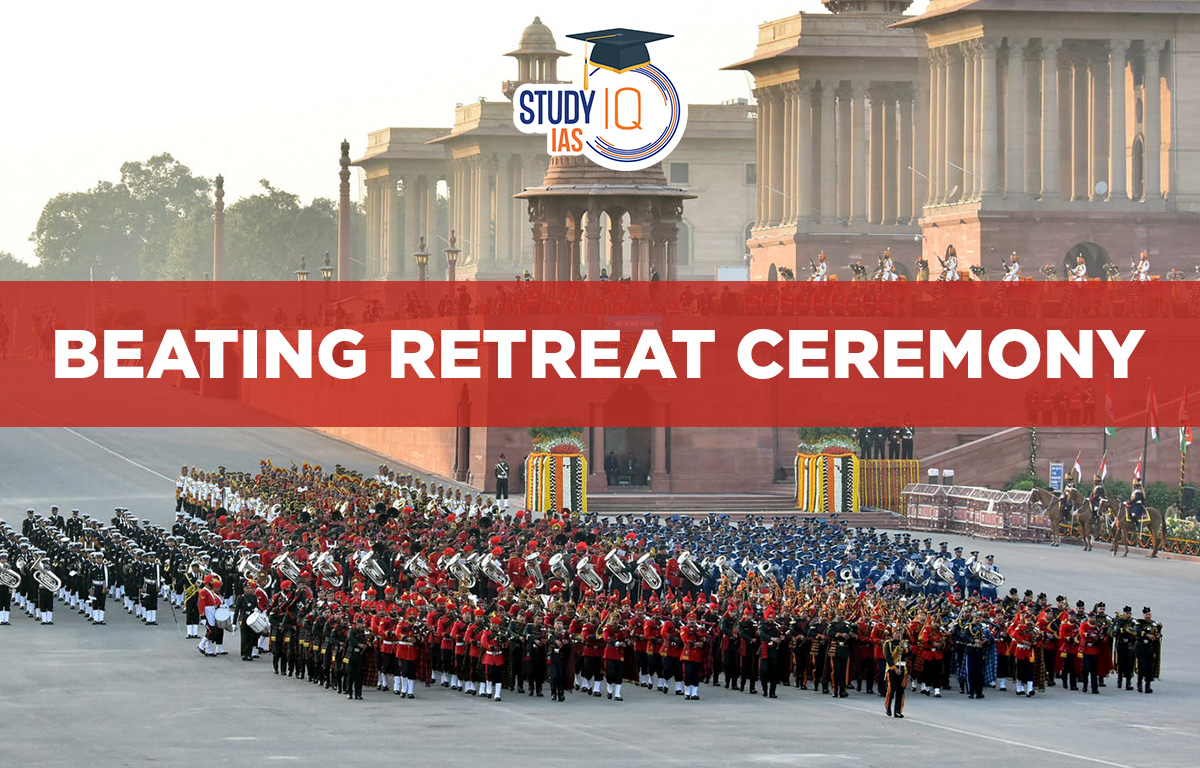Table of Contents
The Beating Retreat Ceremony 2025 marks the grand conclusion of India’s 76th Republic Day celebrations. This annual event, held at Vijay Chowk, New Delhi, is a spectacular musical performance featuring military bands, symbolizing a formal end to Republic Day festivities.
What is Beating Retreat Ceremony?
January 26th, every year, is observed as Republic Day to commemorate the signing of the Constitution of India. Since the Indian Constitution took effect on January 26, 1950, this day is observed with much ceremony. On the other hand, there is another Republic Day celebration that takes place on January 29th every year, and that is the Beating Retreat Ceremony.
The Beating Retreat Ceremony takes place at Vijay Chowk on January 29th of each year. The Beating Retreat Events puts an end to Republic Day 2025 celebrations. As the Supreme Commander of the Armed Forces, the Indian President attended the ceremony. Flags are lowered during the ritual at dusk.
Key Highlights of Beating Retreat 2025
- Date & Time: January 29, 2025, from 6:00 PM onwards.
- Venue: Vijay Chowk, New Delhi.
- Presiding Authority: The President of India, who is the supreme commander of the Indian Armed Forces.
- Musical Performances: Bands from the Indian Army, Navy, Air Force, Delhi Police, and the Central Armed Police Forces (CAPF) perform patriotic tunes and martial music.
- Drone Show & Laser Display: A mesmerizing drone light show and synchronized laser performances are expected to enhance this year’s event.
- Tunes Played: Iconic compositions like Sare Jahan Se Achha, Abide With Me, and Vande Mataram create a patriotic atmosphere.
- Special Guest: Various dignitaries, including the Prime Minister, Defence Minister, and Chiefs of the Army, Navy, and Air Force, are in attendance.
Significance of the Beating Retreat Ceremony
- Symbol of Unity & Discipline: The ceremony showcases the synchronization and discipline of India’s armed forces.
- Tribute to the Nation: The event is a tribute to the bravery and sacrifices of Indian soldiers.
- Cultural Heritage: The combination of Western and Indian martial tunes represents the blend of traditions in India’s military history.
- Concluding Republic Day Celebrations: The ceremony formally marks the end of the Republic Day celebrations with great pomp and show.
How to Watch Beating Retreat Ceremony 2025?
- Live Streaming: The event will be broadcast live on Doordarshan and other national news channels.
- Online Viewing: The live stream will also be available on the official government portals and YouTube.
- Public Attendance: Limited passes are available for citizens, which can be obtained through official government sources.
Beating Retreat Ceremony in India
The Beating Retreat Ceremony ritual is said to have touched Indian soil in the early 1950s when the late Queen Elizabeth II and her husband Prince Phillip made their first trip to the country following India’s independence. Jawaharlal Nehru, India’s first Prime Minister, contacted Major Robert of the Indian Army to come up with a magnificent idea for the visit of the British king. The Beating Retreat Ceremony supposedly originated at that time, according to Major Robert, and since this time it has become an integral part of Republic Day.
Raisina Hills is the location of the Beating Retreating Ceremony. The Indian Army’s pipe band, as well as the massed bands of the Indian Air Force, Indian Navy, and Indian Army, execute the Beating Retreating Ceremony. Since 2016, the Central Armed Police Force (CAPF) and Delhi Police bands have also performed at the Beating Retreat Ceremony.
Conclusion
The Beating Retreat Ceremony 2025 is not just a musical spectacle but a powerful symbol of India’s military pride, history, and cultural heritage. With its grand display of military tradition, patriotic fervor, and musical brilliance, it continues to be one of the most awaited events of the Republic Day celebrations.


 Indian Secularism: Constitutional Provis...
Indian Secularism: Constitutional Provis...
 List of GI Tag Products in India 2025, S...
List of GI Tag Products in India 2025, S...
 Hurun Global Unicorn Index 2025: Key Hig...
Hurun Global Unicorn Index 2025: Key Hig...





















